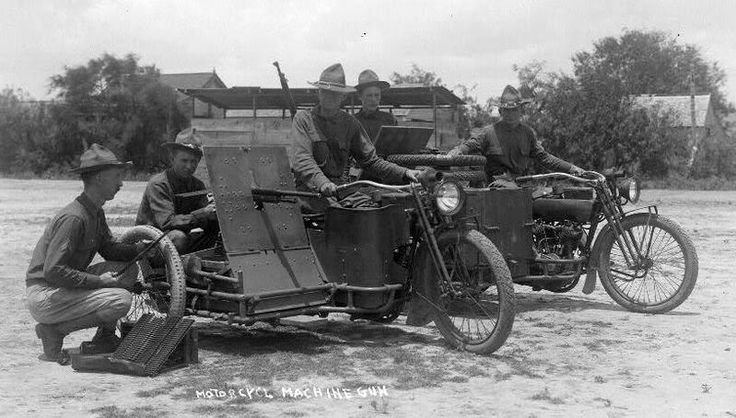Born in Oakdale, CA in 1898, his family soon moved to Oakland. Growing up in Oakland as a young boy, he loved to hang around the nearby Pope Motorcycle dealership. Being a bit of a nuisance and underfoot, he'd soon be chased away but, undeterred, he'd return and kept returning. His persistence paid off when at the age of 12 he was hired on as the shop helper. Ever infatuated with motorcycles, one day while the owner was out Shrimp found his opportunity. He helped himself to one of the Pope lightweight machines for a ride around the block. Soon he was allowed to ride the shop machines to run messages and errands and was occasionally allowed to borrow one for Sunday rides.
On May 4th, 1913 at the young age of 15, Shrimp Burns competed in his first professional race, coming in an impressive 4th place. Again coming in 4th in a 10 mile Championship race in Sacramento later in the year. He quickly became a crowd favorite, known for both his gritty determination and his childish antics. The seasoned racers on the circuit didn't appreciate being shown up by a young boy riding inferior equipment and complained, protesting his young age. The result was his entry being rejected for the next race. Shrimp took it like the young man he was, sitting on the outside track railing making faces at his fellow racers as they sped by... the officials soon had him ejected from the grounds.
Late in the 1913 season he was once again allowed to race at San Jose, California where he won his first title, coming in at 1st place. For the next several seasons, Shrimp Burns continued to race at events around California. His fame continued to grow and he gained a loyal following of fans who loved him for his toughness, as he often raced though injured. Burns once took a hard spill at a race at Marysville, CA and it was thought that he would be done for the day. After hobbling to the pits, Burns fixed his motorcycle, and to everyone's surprise, entered the next race. Although in extreme pain, he took 1st place in the 5 mile event, to the delight of the cheering crowd. Afterwards, when friends insisted upon him seeing a doctor, it was found that he had run, and won, the race despite a fractured collarbone and broken shoulder.
In 1919, Shrimp Burns won the first major race of the western circuit after World War 1, in Fresno, Ca. That June, at the age of 20, he signed a contract with Harley Davidson. He now had access to factory racing machines and the opportunity to race outside his home state of California. On July 4th he made his first appearance on the east coast, where he won a 5 mile race at a National event in Baltimore. As he thrilled crowds with a winning streak throughout the midwest, he became known as one of the country's best riders. At Atlanta, Burns came close to besting the legendary and practically unbeatable Indian racer, Gene Walker. In the final race of 1919, in Sheperdsville Kentucky, Shrimp Burns won a 100 mile National Championship, beating the famous Ralph Hepburn by mere inches.
Burns shocked his fans when it was revealed that he had switched loyalties for the 1920 racing season. Instead of riding for Harley Davidson, who he felt was unfairly promoting other team members above himself, he would now race for Indian Motorcycle, who had promised him only the best equipment. Regardless of mounts, he again began to rack up the wins, claiming the first National title of 1920 at Ascot Park, Los Angeles. According to newspaper reports of the day, many of the 15,000 fans in attendance flooded the track, hoisted Burns on their shoulders, and shouted until they were hoarse. Mechanical problems kept him from the winner's podium at both the Dodge City 300 and the Marion Indiana Cornfield Classic of 1920, but he won a 5 mile Championship at Denver.
Shrimp Burns began the 1921 racing season with what may have been the most spectacular win of his career. On April 24, at the newly built 1.25 mile boardtrack in Beverly Hills, California Burns won the 1st race of the day. He suffered a crash in the next event and appeared badly injured. With both hands and arms bloodied and full of splinters, it looked as though he was out for the remainder of the day. When, later in the day, it was announced that he would compete in the final race of the day, the crowd came to it's feet. Burns soon appeared at the race's start on a borrowed motorcycle, with both arms and hands wrapped in bandages. For most of the race, it looked as though Burns was taking it easy, staying in the middle of the pack and drafting behind other riders. Then, on the last lap, Burns unexpectedly went high on the final turn and suddenly shot down the steep bank, passing the leaders as thought shot from a gun and spectacularly taking the win. (Link to video here... https://youtu.be/ANyxZVWBWlg)
Then on August 14th of 1921, tragedy struck. At a race at Toledo, Ohio, just two days after his 23rd birthday, Burns ran into the rear of Ray Weishaar's motorcycle coming out of a turn. Burns was sent headlong into the track's outer railing. He later died of his head injuries. His young fiancée, Genevieve Moritz, had earlier arrived to bring him a birthday gift. Staying to watch the race, she witnessed the fatal crash. Burns's death was one of many of the boardtrack era, but it was one of the most hard felt. He was deeply mourned by both fans and fellow racers nationwide.


























